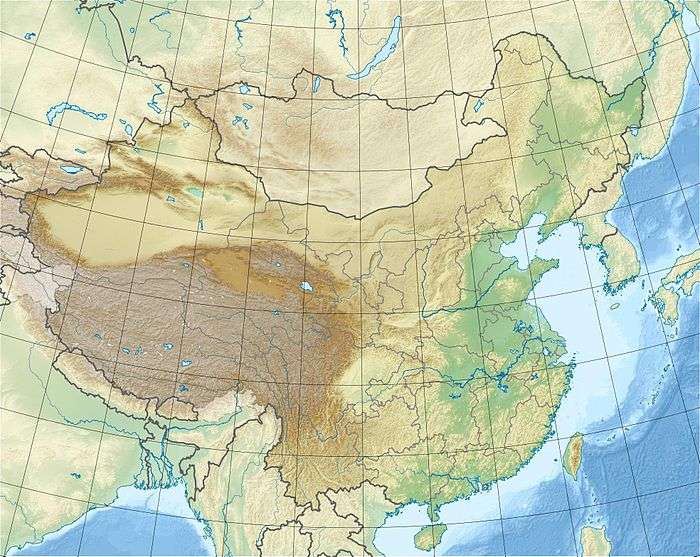Baogang Tailings Dam
Baogang Tailings Dam, also known as the Baotou Tailings Dam or Weikuang Dam, is a tailings dam in Inner Mongolia, China, on the outer ring of the city of Baotou, about 20 kilometres from the city centre. The dam is filled with tailings and waste slurry from nearby rare earth mineral refinery plants. Accounts of the tailings dam appeared in western media outlets after a visit in 2015 by British writers Tim Maughan, Liam Young and Kate Davies from Unknown Fields, a "nomadic design studio" from London.[1][2]Footage posted on YouTube by Maughan appears to show him collecting samples from the floor of the dam. Maughan's account contrasts with the Chinese media's own reporting of the rare earth industry in the area. [3] In 2016, Chinese authorities identified contamination of farmlands surrounding the dam.[4]
| Baogang Tailings Dam | |
|---|---|
 Location of Baogang Tailings Dam in China | |
| Location | Baotou |
| Coordinates | 40°38′16.3″N 109°41′16.7″E |
| Construction began | 1955 |
| Opening date | 1965 |
| Owner(s) | Baotou Steel |
| Dam and spillways | |
| Type of dam | Embankment, tailings |
| Height | 6 m (20 ft) |
| Length | 11.5 km (7.1 mi) |
| Elevation at crest | 1,045 m (3,428 ft) |
| Reservoir | |
| Total capacity | 85,000,000 m3 (69,000 acre⋅ft) |
| Active capacity | 68,800,000 m3 (55,800 acre⋅ft) |
| Surface area | 10 km2 (3.9 sq mi) |
Construction of the dam began in 1955 and it was complete in 1963 but was not used until 1965. It is owned by Baotou Steel. The circular dam is 11.5 km (7.1 mi) long and has a 85,000,000 m3 (69,000 acre⋅ft) capacity. The dam will eventually increase 1,045 m (3,428 ft) in height and have a capacity of 233,800,000 m3 (189,500 acre⋅ft).[5][6]
Bayan Obo Mining District, about 120 kilometres from Baotou city is the world's biggest supplier of rare earth minerals. They are used in the production of smartphones, tablets and other technology, like wind turbines. Production creates millions of tons of waste per year which has drawn much criticism of the dam.[7] Chemicals in the dam have been linked to lower crop yields in surrounding farmlands and serious health problems among local villagers.[8]
References
- Maughan, Tim. "The dystopian lake filled by the world´s tech lust". BBC. Retrieved 6 January 2016.
- Ryan, Rowena. "Baotou is the world's biggest supplier of rare earth minerals and it's hell on Earth". news.com.au. Retrieved 5 October 2018.
- Meng, Fanbin. "Huge rare earth industrial park coming to Inner Mongolia". China Daily. Retrieved 5 October 2018.
- Baochuan Li; Nanping Wang; Jianhua Wan; Shengqing Xiong; Hongtao Liu; Shijun Li; Rong Zhao. "In-situ gamma-ray survey of rare-earth tailings dams - A case study in Baotou and Bayan Obo Districts, China" (PDF). Journal of Environmental Radioactivity 151 (2016). Retrieved 4 October 2018.
- "Baotou Steel Group tailings line monitoring system" (in Chinese). Beijing China test-chi Technology Co., Ltd. Archived from the original on 21 January 2016. Retrieved 8 January 2016.
- Capilla, Antonio Valero; Delgado, Alicia Valero. Thanatia: The Destiny of the Earth's Mineral Resources: A Thermodynamic Cradle-to-Cradle Assessment. World Scientific. p. 243. ISBN 9814602493.
- Breslin, Sean. "Toxic Lake in Inner Mongolia Created By World's Addiction To High-Tech Gadgets". Weather.com. Retrieved 6 January 2016.
- Kiggins, Ryan David. The Political Economy of Rare Earth Elements: Rising Powers and Technological Change. Palgrave Macmillan. ISBN 9781137364258.